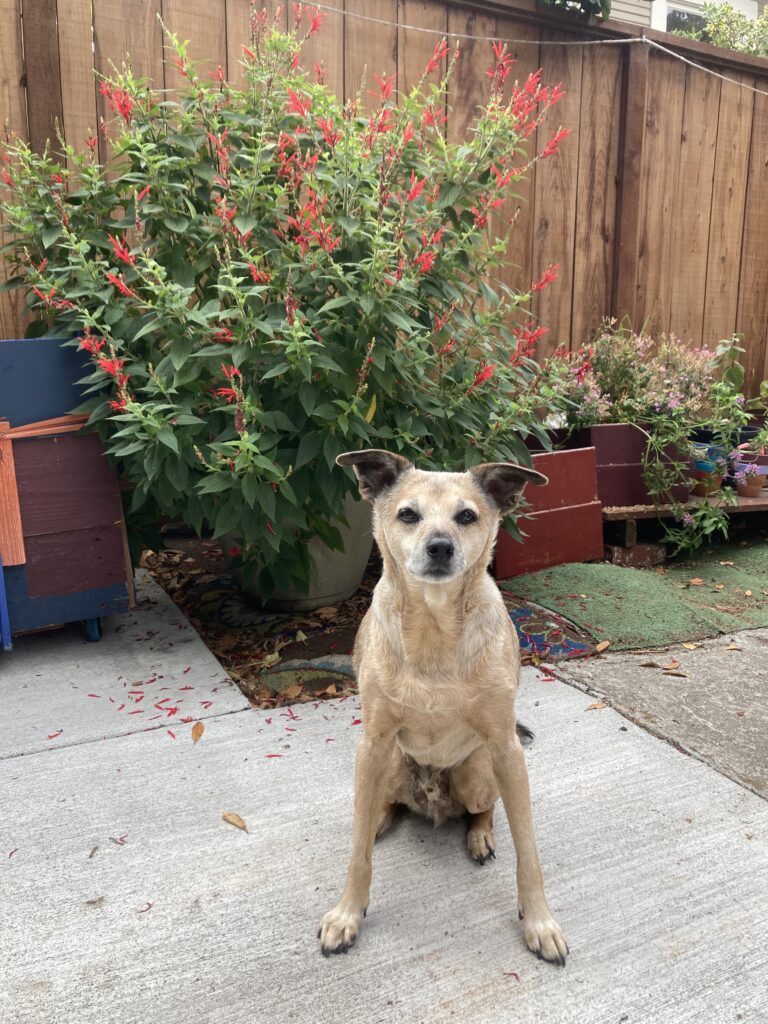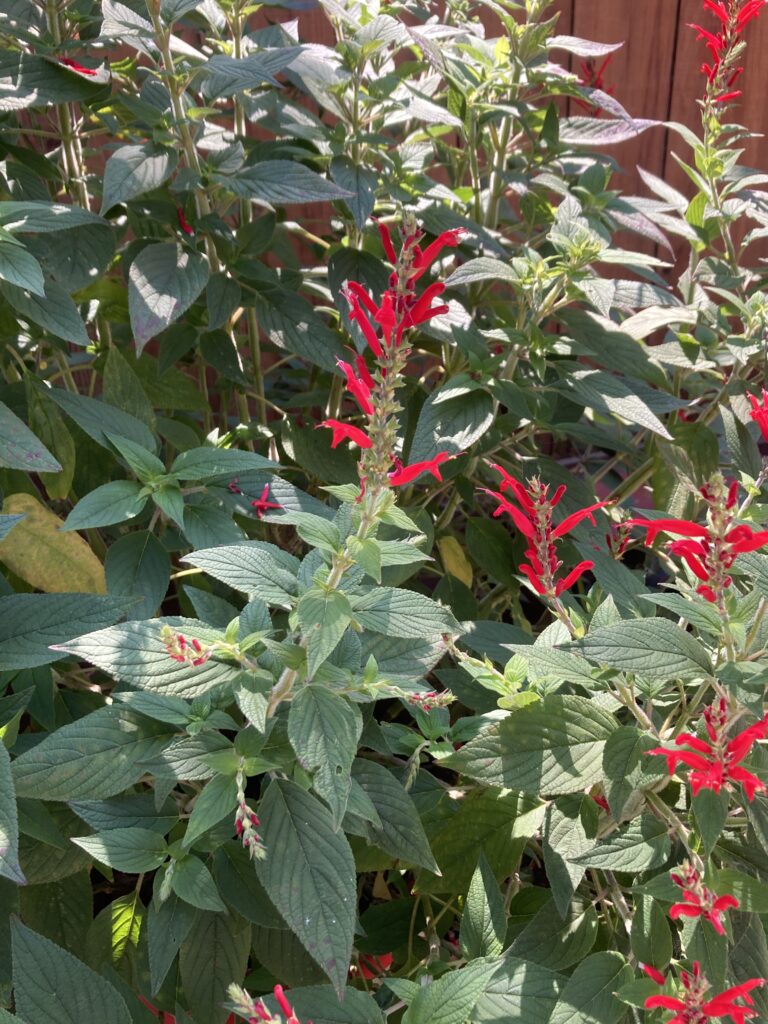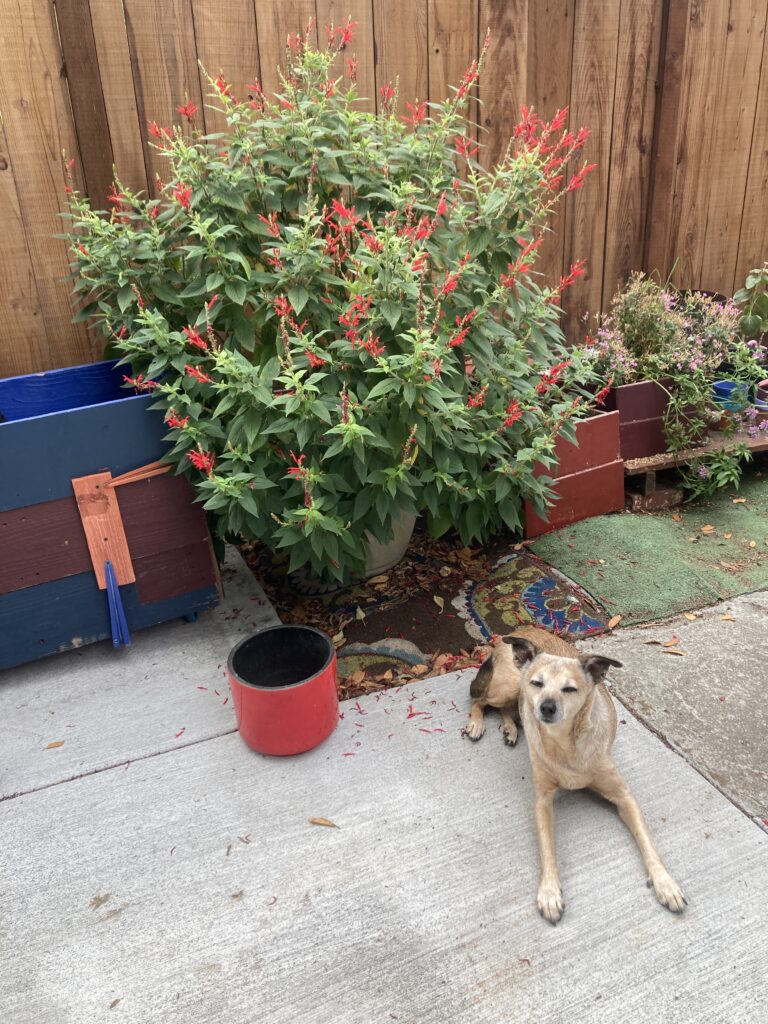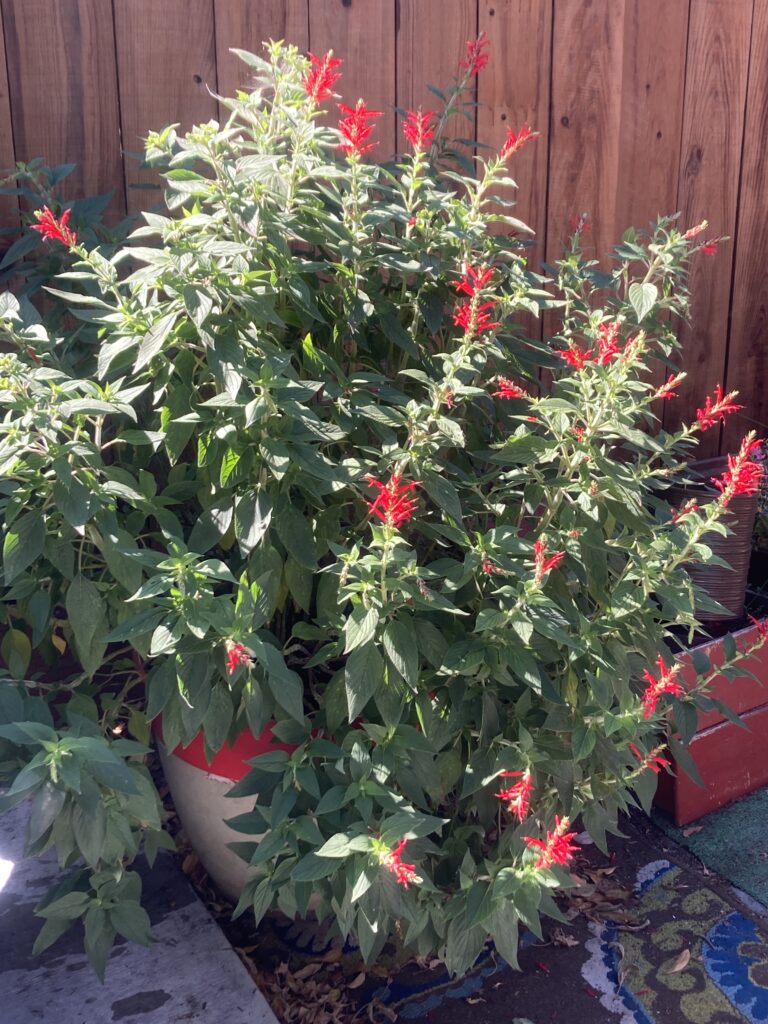Salvia Elegans aka Pineapple Sage is Safe for Cats & Dogs
Pineapple sage is not toxic to dogs or cats and thank goodness for that because it is one of our favorites; well, my favorites as Lovie is indifferent to the scent that captivates me and hypnotizes hummingbirds. I would venture to be that you too will love the bright, fruity aroma that is invigorating. I love seeing the hummingbirds delighting in the sucking the nectar from the bright red, tubular flowers. I created a floral track for them by growing plants from cuttings from one original plant- yes, it propagates well so you can invest once and benefit many times over.

Physical Attributes
| Attribute | Description |
|---|---|
| Plant Type | Tender perennial herb or semi-woody subshrub[1][2][3] |
| Height | 2-4 feet tall[2][3] |
| Spread | 3-4 feet wide[2][3] |
| Leaves | Bright green, ovate, 2-4 inches long, softly fuzzy, pineapple aroma when crushed[2][3] |
| Flowers | Brilliant red, tubular, 1-2 inches long, in terminal spikes[1][2][3] |
| Bloom Time | Late summer to fall, can bloom year-round in warm climates[2][3] |
| Growth Habit | Upright, bushy, open branching[2][3] |

General Care Tips
- Grow in full sun[2][3]
- Well-drained soil[2][3]
- Drought tolerant once established, but looks best with regular watering[2][3]
- Pinch back when young to promote bushiness[3]
- Remove old, woody stems in spring[3]
- Bring plants indoors or take cuttings before frost in cold climates[2][3]
- Hardy in zones 8-11, grown as an annual in cooler regions[2][3]
Fun Facts
- Native to highlands of Mexico and Guatemala[2][3]
- Leaves and flowers have a sweet pineapple-like aroma and flavor[1][2][3]
- Attracts hummingbirds, butterflies, and other pollinators[1][2][3]
- Edible flowers used in teas, jellies, baked goods, cocktails[2]
- Traditional Mexican medicine uses it for anxiety and high blood pressure[2]
- Name derived from the Latin salvare meaning “to heal”[3]
- Cultivars like ‘Golden Delicious’ have bright chartreuse foliage[3]

Pineapple Sage/Salvia Elegans Pet Safe Flowering Plant for Dogs, Cats & Horses:
We check the flowers we feature on our site with the ASPCA website list of nontoxic versus toxic plants and do extensive internet research for both the common and scientific name just to be super pet safe. If we cannot find direct reference, we check up to genus and so on until we can confirm whether a plant is toxic or non toxic to either cats or dogs. If we are not sure, or get contradictory information, we do not include it. Many of the plants featured we have grown successfully in our own pet safe garden in Northern California. You can see many of garden stars in photos from Lovie’s Pet Safe Garden. Pineapple sage is one of our favorite flowering plants that are safe for dogs, cats and horses.
| Consideration | Details |
|---|---|
| Container Friendly | Yes, pineapple sage does well in large containers and patio planters.[1][2][4] |
| Indoor/Outdoor | Outdoor plant, can be brought indoors before frost in cold climates.[2][4] |
| Sun/Shade | Prefers full sun, tolerates partial shade in hot climates.[1][2][4] |
| Perennial/Annual | Tender perennial in zones 8-11, grown as an annual in cooler regions.[1][2][3][4][5] |
| Flowering | Brilliant red tubular flowers bloom in late summer to fall.[1][2][3][4][5] |
| Drought Tolerant | Somewhat drought tolerant once established.[1][4] |
| Pollinator Magnet | Yes, attracts hummingbirds, butterflies, and bees.[1][2][3][4] |
| Beginner Friendly | Yes, considered easy to grow and low maintenance.[1][2][4] |
| Good Ground Cover | No, grows upright and bushy, not a ground cover plant.[1][2][3][4][5] |
| Good Privacy Screen | No, maximum height around 4-5 feet, too short for an effective privacy screen.[1][2][4][5] |
| Invasive/Spreader | No, not considered invasive or an aggressive spreader.[1][2][3][4][5] |
| Hardy/Delicate | Tender perennial, damaged by hard frosts below 20°F.[2][4][5] |
| Rodent Repellent | No specific evidence of rodent repelling ability.[1][2][3][4][5] |
| Deer Resistant | Yes, deer resistant.[1][4] |
| Native To | Native to highlands of Mexico and Guatemala.[2][3][4][5] |
| Ideal States/Regions | Hardy perennial in USDA zones 8-11. Grown as an annual elsewhere.[1][2][3][4][5] |

Citations:
[1] https://www.gardenia.net/plant/salvia-elegans
[2] https://www.uaex.uada.edu/yard-garden/resource-library/plant-week/Salvia-elegans-Pineapple-Sage-10-16-2015.aspx
[3] https://www.etsy.com/listing/836976077/salvia-elegans-pineapple-sage-plant-in
[4] https://www.thespruce.com/pineapple-sage-growing-guide-5222335
[5] https://hort.extension.wisc.edu/articles/pineapple-sage-salvia-elegans/
[6] https://www.etsy.com/listing/836976077/salvia-elegans-pineapple-sage-plant-in
[7] https://www.finegardening.com/article/pineapple-sage-salvia-elegans
[8] https://hort.extension.wisc.edu/articles/pineapple-sage-salvia-elegans/
[9] https://www.gardenia.net/plant/salvia-spathacea
[10] https://www.smgrowers.com/products/plants/plantdisplay.asp?plant_id=1459





